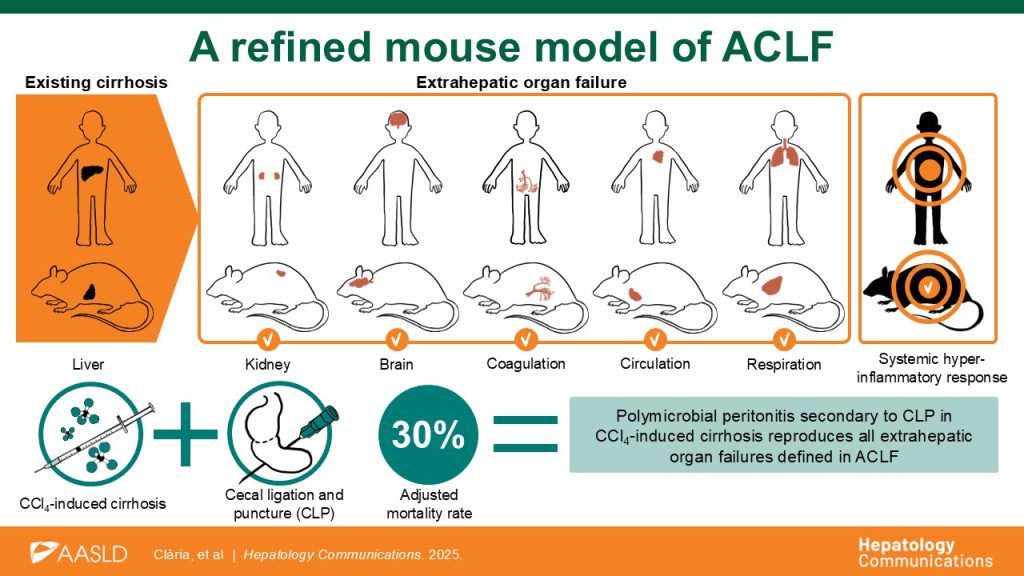Menu

Acute-on-chronic liver failure is a severe complication of cirrhosis marked by rapid deterioration of multiple organs and high short-term mortality. Despite increasing knowledge of its clinical presentation, the mechanisms that drive ACLF remain poorly understood, in large part because there have been no reliable experimental models to study the condition in detail.
A new study describes a robust murine model that recreates the liver and extrahepatic organ failures observed in patients with ACLF. The model combines chemically induced liver cirrhosis with polymicrobial peritonitis, a common trigger of ACLF in clinical settings, induced by cecal ligation and puncture (CLP). The result is a preclinical model that not only captures the clinical heterogeneity of ACLF but also offers a valuable tool for translational research.
“One of the most pressing challenges in ACLF research has been the absence of animal models that reflect the complexity of the disease as seen in humans, especially of a model that fully reproduces all extrahepatic organ failures”, said Prof. Joan Clària, senior author in the paper, Director of the Grifols Chair and Head of Translational Operations at EF CLIF, and Group Leader of the Inflammation and Liver Disease group at Hospital Clínic de Barcelona-IDIBAPS. “Our work overcomes this limitation and paves the way for deeper understanding of extrahepatic organ failure development and potential therapeutic strategies”, he added.
The researchers adapted clinical definitions used by the EASL-CLIF Consortium to evaluate the degree of organ impairment in mice, allowing the results to be comparable to the human condition. The model showed consistent signs of liver, kidney, brain, coagulation, circulatory, and respiratory impairments along with systemic inflammation and high short-term mortality—hallmarks of ACLF.
The model also reflects the variability of ACLF severity, offering a way to investigate different phenotypes of the disease. This variability is both a strength and a limitation—it mimics clinical heterogeneity but also requires careful calibration to ensure reproducibility. Despite these challenges, the authors emphasize the model’s potential to transform preclinical research.
“Being able to replicate the full spectrum of ACLF in mice offers a unique opportunity to study the drivers of disease in ways that aren’t possible in critically ill patients”, explained Dr. Cristina Lopez-Vicario, postdoctoral researcher at Hospital Clínic de Barcelona-IDIBAPS. “We now have a tool that brings us closer to understanding what actually causes ACLF to progress so rapidly and why some organs fail while others don’t. This is the foundation that we need to move towards safe and effective treatments”, she concluded.
The Inflammation and Liver Disease group at Hospital Clínic de Barcelona-IDIBAPS is supported by the Centro de Investigación Biomédica en Red de Enfermedades Hepáticas y Digestivas (CIBEREHD), Instituto de Salud Carlos III, Spain.
Other authors in the study are Roger Flores-Costa, Marta Duran-Güell, Berta Romero-Grimaldo, Bryan J. Contreras, Albert Salvatella, María Belén Sánchez-Rodríguez, Frank Uschner, Sabine Klein, Alba Diaz, Estefanía Huergo, David Gómez-Cabrero, Jordi Bosch, Pierre-Emmanuel Rautou, and Jonel Trebicka.
Flores-Costa R, Duran-Güell M, Romero-Grimaldo B, Contreras BJ, Salvatella A, Sánchez-Rodríguez MB, Uschner F, Klein S, Diaz A, Huergo E, Gómez-Cabrero D, Bosch J, Rautou P-E, Trebicka J, López-Vicario C, Clària J. An optimized peritonitis-induced ACLF model that reproduces the full spectrum of extrahepatic organ failures in mice. Hepatol Commun 2025; 9(7):e0744. DOI: 10.1097/hc9.0000000000000744
European Foundation for the Study of
Chronic Liver Failure
Avinguda Diagonal 477, 11th floor
08036 Barcelona, Spain
Tel: +34 93 227 14 00
Email: Send us an email
© 2025 European Foundation for the Study of Chronic Liver Failure

| Cookie | Duration | Description |
|---|---|---|
| cookielawinfo-checkbox-analytics | 11 months | This cookie is set by GDPR Cookie Consent plugin. The cookie is used to store the user consent for the cookies in the category "Analytics". |
| cookielawinfo-checkbox-functional | 11 months | The cookie is set by GDPR cookie consent to record the user consent for the cookies in the category "Functional". |
| cookielawinfo-checkbox-necessary | 11 months | This cookie is set by GDPR Cookie Consent plugin. The cookies is used to store the user consent for the cookies in the category "Necessary". |
| cookielawinfo-checkbox-others | 11 months | This cookie is set by GDPR Cookie Consent plugin. The cookie is used to store the user consent for the cookies in the category "Other. |
| cookielawinfo-checkbox-performance | 11 months | This cookie is set by GDPR Cookie Consent plugin. The cookie is used to store the user consent for the cookies in the category "Performance". |
| viewed_cookie_policy | 11 months | The cookie is set by the GDPR Cookie Consent plugin and is used to store whether or not user has consented to the use of cookies. It does not store any personal data. |